With circulation, light and ventilation guidelines violated in the construction of properties built under the state’s Slum Rehabilitation Authority scheme, desperate residents turn to fans and ACs that overload electrical circuits. The result is a surefire disaster in the making
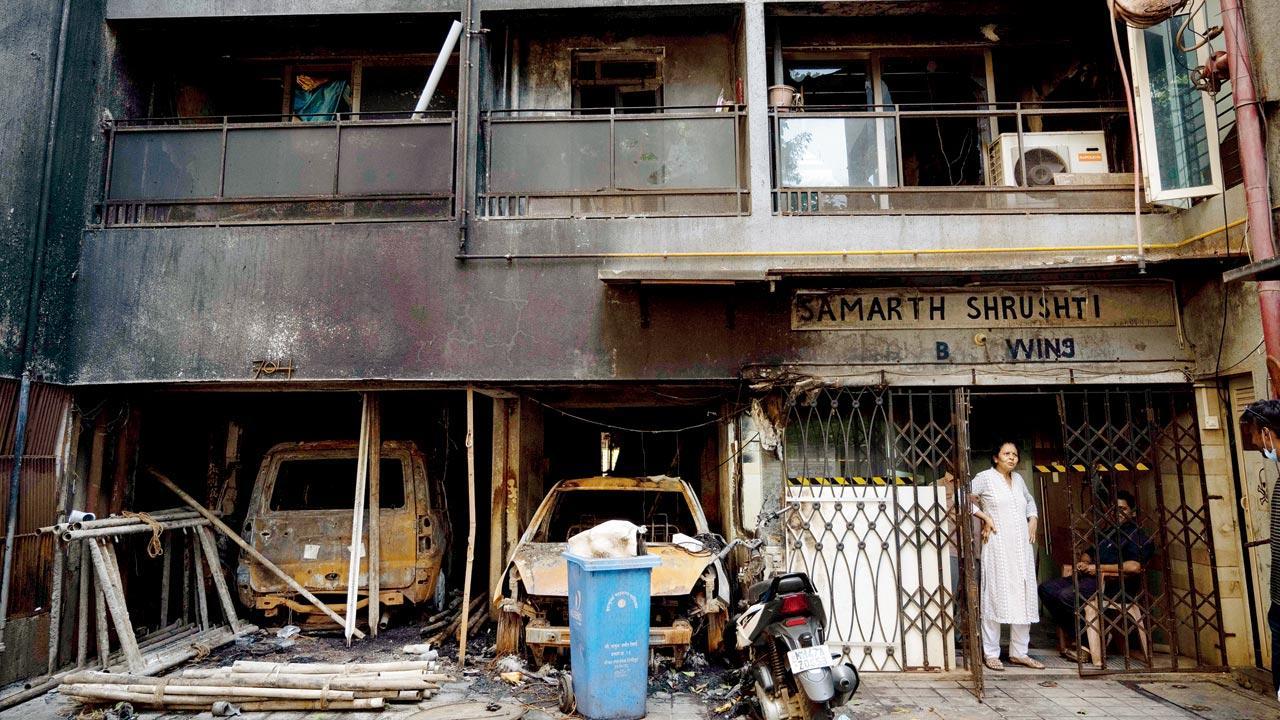
A fire broke out at an SRA building in Goregaon West on October 6, killing seven people including two minors. The building was constructed in 2006 and did not have a fire-fighting system, according to reports. Pic/Getty Images
As soon as you step into the 12-storey building no. 7 in the E wing of the Slum Rehabilitation Authority’s Premier Complex in Kurla West, the stench of urine hits you like a sledgehammer. The walls of the dusty stairwell are covered in black soot, and the fire duct that runs through the middle of the stairs all the way to the last floor, is also badly charred.
On September 15, this building escaped a near tragedy, when a fire broke out in the meter box on the ground floor, quickly spreading to the wiring on the upper floors.
We walk up to the ninth floor, where the fire was most intense. Meenadevi Gupta, 49, is lying down on the floor of her 290 sq ft room. The door to her home is ajar. On noticing us, she immediately gets up, and straightens her nightie. She leads us to the diwan cum bed. “It’s too hot here,” she says, “there has been no electricity since the last month, so we prefer to sleep on the floor.”
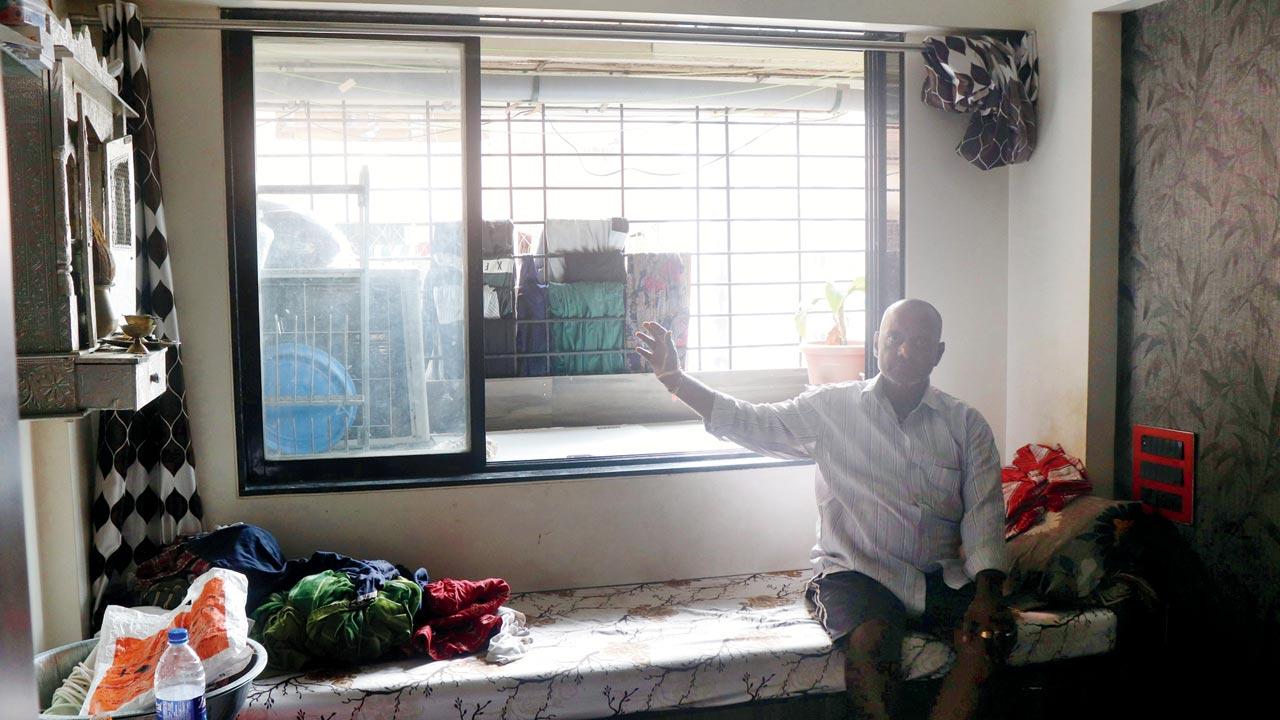 The Guptas climbed onto their window grill to escape the smoke, after a fire broke out in their building last month
The Guptas climbed onto their window grill to escape the smoke, after a fire broke out in their building last month
On the day when the fire broke out, Gupta, her husband Balalakhandar, and two sons, were fast asleep. It was around 11.30 pm, she says. They were woken up by the commotion outside. “Our neighbours were trying to escape down the stairs, but the corridor was engulfed in thick, black smoke,” Gupta recalls. The fire-retardant door, which houses the meter duct, had caught fire, blocking their path. Around eight of them then climbed on to the huge window grill in the Gupta home and shut the sliding window behind them. Help came eventually, and they were evacuated from the building.
While there were no casualties, nearly 40 people were admitted to the nearby Rajawadi Hospital after complaining of suffocation.
Vijay Valmiki’s wife Shakuntala, 38, and daughters Muskaan, 18, and Nisha, 20, were among those admitted. “We live on the 11th floor,” says Valmiki. “Since smoke had engulfed the staircase, we rushed to the terrace on the 12th floor and broke open the door to the next wing.”
 Balalakhandar Gupta with his wife
Balalakhandar Gupta with his wife
By the time they got out, Valmiki’s daughters began vomiting black gunk. “I didn’t wait for anyone to tell me what to do, I just rushed them to Rajawadi.” The family was admitted to the ICU for three days, before they were discharged. “But after a few days, my daughter Nisha began complaining of discomfort while eating. We went to Rajawadi again, and they said that there was a swelling in her throat.”
Soon after the incident, the residents of E Wing moved back to the building, but with no electricity or help from the authorities, living here has become a nightmare. Most of them were rehabilitated from Tulsi Pipe Road in 2016, after a long and painful negotiation with the BMC.
Chabban Chavan, 45, the neighbour who took refuge with the Guptas, is an auto-rickshaw driver. He says that many of the residents living in the 93 flats are daily wage earners, and cannot afford to repair the electrical wiring. “We have been told that the repair work would cost us around Rs 12-13 lakh. Right now, many of them can’t even afford to pay Rs 600 as maintenance charge per month,” he says, showing us the damage on each floor.
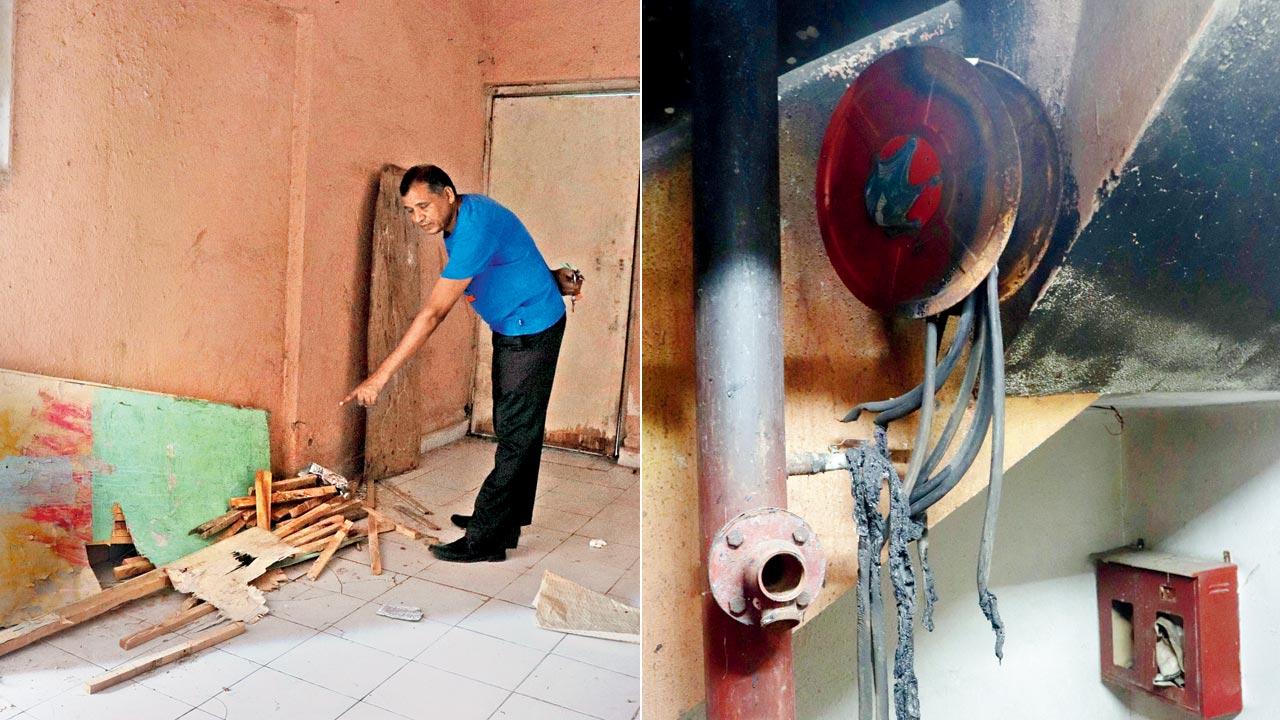 Vijay Valmiki, who resides on the 11th floor of the Kurla SRA building, had to break open the door of the terrace to crossover to the F Wing, to escape; (right) Charred remains of a fire hose in the Kurla building. While every floor has a hose, they were rendered unusable, because the fire originated in the meter box. A fire hose reel is never used in an electrical fire. Pics/Anurag Ahire
Vijay Valmiki, who resides on the 11th floor of the Kurla SRA building, had to break open the door of the terrace to crossover to the F Wing, to escape; (right) Charred remains of a fire hose in the Kurla building. While every floor has a hose, they were rendered unusable, because the fire originated in the meter box. A fire hose reel is never used in an electrical fire. Pics/Anurag Ahire
Chavan says that residents of the neighbouring buildings have come to their aid. Ramveer Paracha, 62, who lives in the F Wing, says that they have allowed the affected residents to take electricity from their plug points, to charge their phones. “What else can we do?” Paracha asks, “It’s going to be nearly impossible for them to pool in resources to fix their wiring.”
The Slum Rehabilitation Authority (SRA) was established in 1997 with the aim of providing 10 lakh homes to slum dwellers in 10 years. But, according to a
survey conducted in 2020 by Mumbai-based IMK Architects, only two lakh homes have been built until now, at the rate of 8,000 homes per year. What’s more concerning is that these buildings are lying in neglect, and have become firetraps.
In last two years, three fire incidents have been reported in the same SRA complex in Kurla—the G Wing saw a small fire in 2021, and in February this year, a fire was reported in the C Wing.
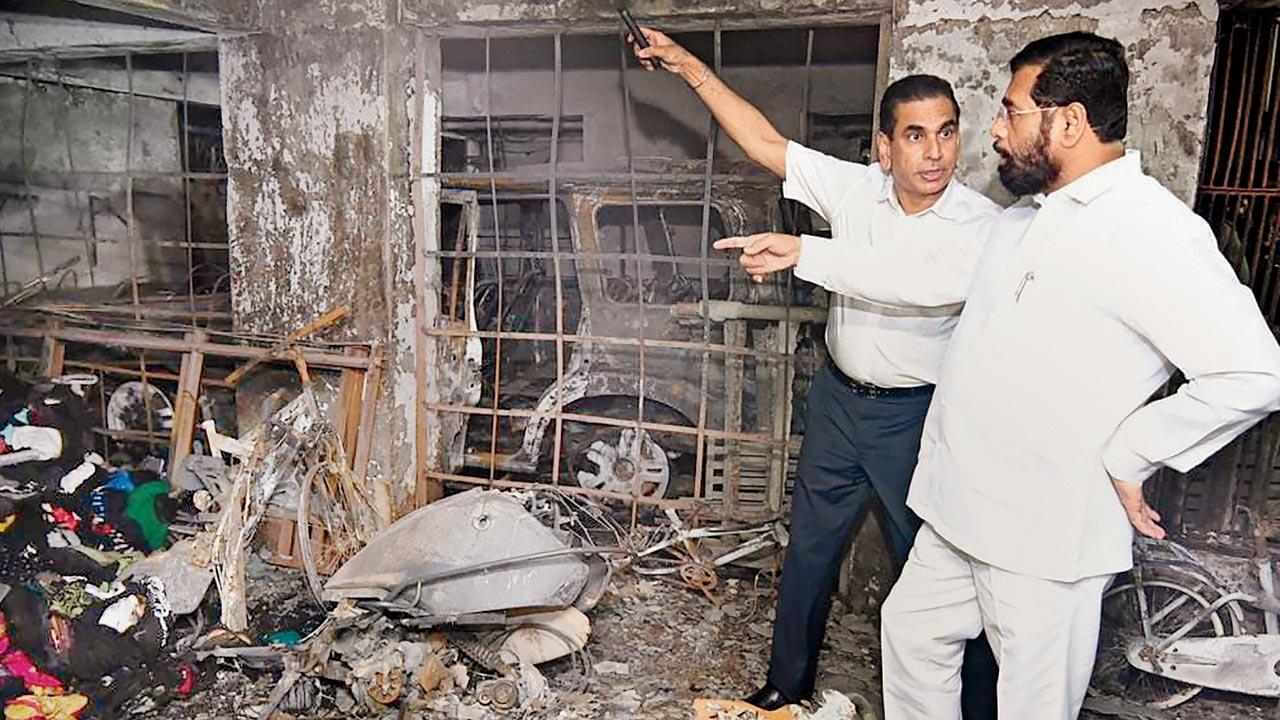 CM Eknath Shinde and BMC chief Iqbal Singh Chahal visit the SRA building in Goregaon West, where a fire broke out on October 6, killing seven people. The CM has directed officials to carry out fire audits of all SRA projects. Pic/PTI
CM Eknath Shinde and BMC chief Iqbal Singh Chahal visit the SRA building in Goregaon West, where a fire broke out on October 6, killing seven people. The CM has directed officials to carry out fire audits of all SRA projects. Pic/PTI
SRA buildings across the city are plagued with a similar problem.
On October 6, a devastating blaze caused due to a short circuit in an SRA building in Goregaon West killed seven people, including two minors, and left 62 injured. Chief Minister Eknath Shinde last week directed officials to carry out fire audits of all SRA projects. Satish Lokhande, CEO of SRA, also told mid-day that the BMC commissioner was going to begin auditing fire prevention systems in all SRA buildings, and install metal grill staircases in the buildings, so that they could be used as fire escapes. But would these measures be enough?
Former MHADA president, member of MMRRDA and the SRA authority, researcher, architect, professor, and urban planner and management expert Chandrashekhar Prabhu has been studying and opining on SRA policy and buildings since its inception. “The concept of giving windfall profits to unscrupulous builders created and encouraged predatory grabbing of prime properties,” he says.
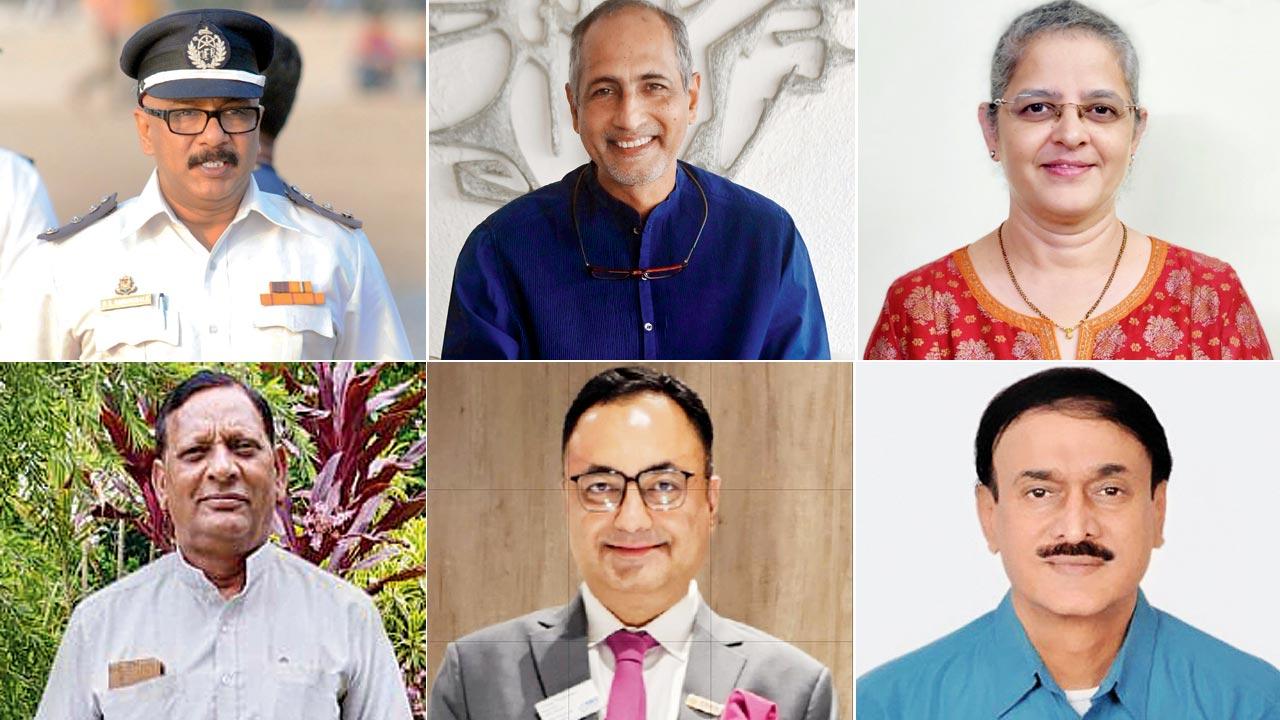 Prabhat Rahangdale, Rahul Kadri, Anuprita Dixit, Ramveer Paracha, Vishal Wadhwani and Chandrashekhar Prabhu
Prabhat Rahangdale, Rahul Kadri, Anuprita Dixit, Ramveer Paracha, Vishal Wadhwani and Chandrashekhar Prabhu
In return, they built structures that violated all regulations. The design of these buildings, he says, tick all the wrong boxes. “This is exactly what I tell my students not to do,” Prabhu says, explaining, “The designs are pathetic, and do not allow for adequacy in all vital parameters including circulation, light and ventilation. Due to this, people use high power artificial lighting, multiple exhaust fans, other high consumption gadgets, usually get ACs fitted inside the flat, keeping it on throughout the day and night. This overburdens the electrical system. It has been conclusively proved that bad planning leads to incidents like we saw in both Kurla and Goregaon.”
Ex-chief fire officer Prabhat Randhale, who retired in 2022, says that in 2016, when the fire brigade had attended to a fire in an SRA building in Mahalaxmi, they had found that the residents had overloaded their electrical unit. Another issue, he says, is that many of these homes are used as storage units. “People rent the flats out to businesses to store goods. Some of these storage items, like clothes, serve as cinder to these fires.”
Rahul Kadri is the partner and principal architect at IMK Architects. According to him, most of the rules of design are diluted for state housing projects, because authorities are in a rush to get people off the roads. “They are of the mindset that at least we are giving them free homes.”
As per regulation, the distance between buildings must be 1/4th of their height. “So, a 20-storey building needs to have a gap of 10 metres with the next.” There’s a blatant violation of these rules in SRA buildings. “That’s why, a lot of times, we see that the fire spreads quickly from one wing to the other.” Kadri says buildings should also be designed in a way that sunlight falls on all sides of the room, and at different times of the day. “Because these designs do not encourage this, it also causes psychological and health issues among residents. They tend to get angrier and violent, and as far as the body is concerned, they end up with pulmonary issues like tuberculosis,” he says.
Prabhu points to an experiment of affordable housing conducted in the US back in 1954 called Pruitt-Igoe, developed in the city of St Louis in Missouri. The project for the poor consisted of 33 11-storey buildings. “But as soon as the residents moved in, they felt trapped and claustrophobic. Mental health issues were also on the rise. Eventually, the crime rate in the city went up by 10 times in the decade that these buildings were occupied. Finally, in 1972, around 300 flats were brought down with a dynamite in a contained implosion,” informs Prabhu.
The SRA buildings in Mumbai, Prabhu says, are a grim reminder of the unsuccessful Pruitt-Igoe. “The SRA as a policy is a complete failure, and it is high time that we scrap the existing policy and come up with a people-friendly policy with proper planning guidelines and encouragement to self-redevelopment which the existing laws have enough provisions.”
Anuprita Dixit, design director at IMK Architects, echoes this sentiment. She and her team have been looking for solutions for safer, affordable housing. “Developers often cheat [the authorities] by showing a greater number of residents in an area, in order to secure more FSI to build extra flats. They then sell them at a huge profit,” she says. “We found that it would be a better option for residents to approach a developer themselves,” she adds.
Prabhu has already submitted a detailed housing policy in 12 volumes, “but the builder-politician-bureaucrat-underworld nexus has been sitting on it for years”.
Despite SRA buildings not being fire-poof, they continue to be most sought after among the lower middle-class. Thane-based asset advisor Vishal Wadhwani, says, “For a person who has moved to city, after selling his home in the village, there are just two options—he/she can either buy a shanty with that money, or a home in an SRA building, which is one step above a chawl. This is the average customer for an SRA home.” That many people are selling their flats—as per the law, you cannot sell an SRA home before 10 years—and even giving it out on rents of Rs 15,000-Rs 20,000, means these homes are available in plenty.
Prabhu also blames residents for the current state of SRA buildings. “Residents do not bother to upgrade their electrical system and that’s why we see these fires.” Ex-chief fire officer Prabhat Randhale suspects that the fire audits might be a futile exercise, after all. “Even if we carry out fire audits and suggest solutions in the wiring system, residents don’t have the money to make the required changes. What’s the point then?”
As we leave the E wing of the Kurla SRA building, we tell the residents that they were lucky that their wings had interconnected terraces and corridors. One of them immediately responds, “Well they [the authorities] thought that we are definitely going to die because of a fire, so at least let us give them an escape route.”
2L
No. of SRA homes built since 1997
 Subscribe today by clicking the link and stay updated with the latest news!" Click here!
Subscribe today by clicking the link and stay updated with the latest news!" Click here!










